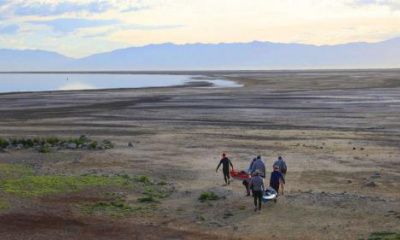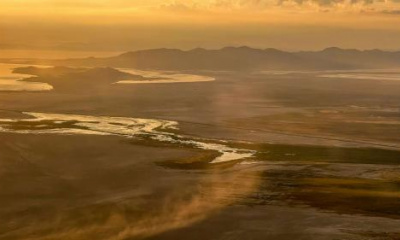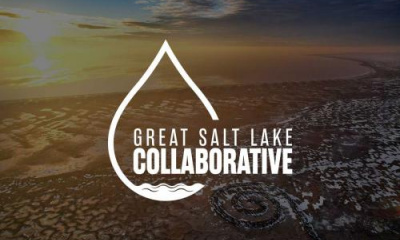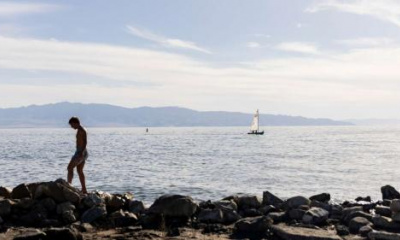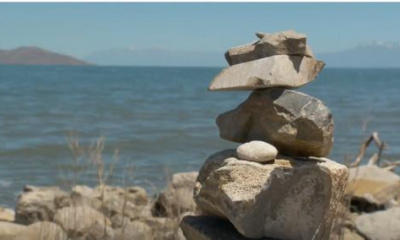Commissioner Brian Steed breaks down legislation affecting the Great Salt Lake
Baby steps and long jumps. There are advocates who firmly believe the state of Utah is not doing enough to save the ailing Great Salt Lake and others who assert the lake will heal itself, it’s a money pit for unnecessary spending and all this effort aimed at conservation is a way to drive Utah’s growth into the ground and to hang the agricultural community on the sacrificial altar.
Such is the quixotic nature of the lake itself and the politics that surround it.
There are two top players in the policy arena of all things Great Salt Lake, who are slogging through the marshes and wetlands of change, anxiously eyeing weather forecasts, water levels, salinity, the projected spring runoff, temperatures and more.
Brian Steed, who is coming up on a year as the Great Salt Lake Commissioner for Utah, and his deputy director, Tim Davis, are navigating these delicate and uncomfortable conversations, trying to attain symmetry among the discordant voices and arrive at solutions.
“It was a brutal legislative session,” conceded Steed Thursday at a Great Salt Lake legislative briefing hosted by the University of Utah’s Wallace Stegner Center for Land, Resources and the Environment.
Steed said the two legislative sessions prior to 2024 embraced a high-paced tempo.
“We have seen a mad rush on water and policy change.”
Overall, there have been 65 substantive changes in Utah water law in the last five years, which Steed stressed has been no easy feat given the traditionally entrenched nature of water law in the West.
Steed said the initial marathon happened in 2022 and in 2023 after the Great Salt Lake reached its historic recorded low.
Lawmakers convened summits, took aerial tours and poured hundreds of millions of dollars into agricultural water optimization, providing financial incentives for farmers and ranchers in the Great Salt Lake watershed to implement water saving tools for the benefit of the Great Salt Lake.
Then there was the push for secondary water metering, which shows savings of up to 30% if users are simply aware of how much wasted water goes on the ground.
The Great Salt Lake earned its designation as a beneficial water use under water law, meaning the water that gets there is not a waste — but a positive.
If you consider the more than $2 billion California had to invest in Owens Lake dust mitigation, it behooves the urbanized Wasatch Front to tamp that dust coming off of more than half the exposed lake bed made plain by a drying Great Salt Lake. It is more than an ecosystem for birds but part of Utah’s cultural identity and both a public health benefit or detriment, depending on how it is managed.
With the framework in place established in 2022 and 2023, this year was the year for more subtle, but technical and difficult changes that are the nuts and bolts of what needs to be done for the long, medium and short game to provide a viable and healthy future for the Great Salt Lake.
Davis said the challenge is to “measure and show” demonstrable results.
“There is a hunger in the legislature for that, for what is working,” Davis said, adding it cannot be a mere one-off.
“You don’t do it just once, you do this is so it can be sustained over time.”
Producing outcomes
Steed pointed to this year’s passage of HB453, Great Salt Lake Revisions, which sets in motion voluntary agreements with mineral extraction companies via incentives to no longer view the Great Salt Lake as a big bathtub with water for the taking.
While Steed said the legislation is not perfect, it established guardrails for industry behavior on tapping water for business purposes. Unhindered, mineral extraction companies could drill and build canals to secure the necessary water, he said.
How much water?
“It was a terrifying amount,” Steed said.
He also stressed the importance of SB18 and HB61 which provide the tools and the outcomes to measure how much water is “saved,” and other measures that speak to beefing up the bottom line on the water ledger to see what results have played out.
Both Steed and Davis stressed no one should become complacent over the fate of the Great Salt Lake and that people should also refrain from the burnout that may be growing over the issue. There is also a need to be mindful of the value of Utah’s water resources, which can be unpredictable in a fluctuating performance of nature and further stressed by the growth that is happening in Utah.
“We always will be in somewhat of a crisis with water in this state,” Steed said.


